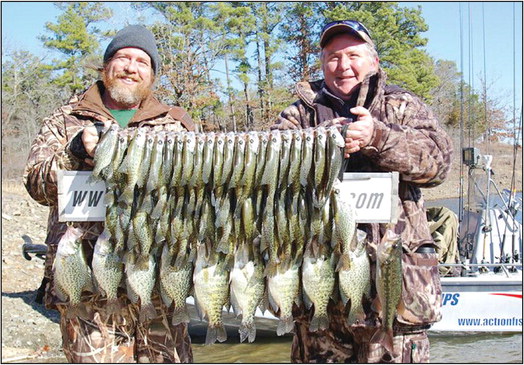12 Fishing tips for the crappie spawn

12 Fishing tips for the crappie spawn
AGFC experts offer advice for your fishing trip this spring
Arkansas Game & Fish Commission LITTLE ROCK – When spring approaches, a large segment of Arkansas anglers think of crappie.
Crappie can be caught any time of the year, but spring and crappie go together like ham and eggs, red beans and rice, grits and gravy. It seems food analogies fit well with the greattasting crappie subject.
Here are a dozen suggestions from the Arkansas Game and Fish Commission for improving your crappie catching skills this spring: 1. Use light line on your pole or rod. Line from 4to 8-pound test allows the minnow or jig to move freely and won’t spook fish.
2. If you are using a float or cork to indicate a strike, add enough split shot weight above your hook or use a heavy enough jig to keep the float sitting low on the surface of the water. That way the slightest nibble will pull enough to sink the cork or get it to pop upward.
3. If you prefer not to use a float and feel for the “thump” of a strike, use a sensitive rod made out of graphite. If you use a pole, go for a light one. Lowstretch fluorocarbon line also can help you feel the bite better.
4. Don’t set the hook like you’re driving the hook home with a hammer.
Crappie have tender mouths and can tear easily. Use sharp, thin-wire hooks and simply lift with a quick snap of the wrist to set the hook.
5. Find the edges of grass and weeds that are starting to sprout with some green tips. Crappie will use these weed beds for cover and to feed on small insects hatching in the vegetation.
6. If you are using live minnows, be sure to take care of your bait with an aerated livewell. The livelier the bait, the better the bite.
7. At the end of the day, DO NOT dump your remaining bait into the lake. Dispose of them on land to prevent the spread of disease and aquatic nuisance species that could be transmitted with the baitfish.
8. Look for drop-offs.
Crappie tend to hang out at the same depth, so fish at the same depth while trolling or working this kind of structure.
9. Pay attention to the water color. Crappie usually hold shallower when the water is stained, dingy or muddy than when the water is clear. It is not uncommon for crappie to spawn in 8 feet of water on clear-water lakes, while muddier bodies of water will see crappies spawning so shallow you can see faintly their dorsal fins at the surface.
10. Try to keep your distance from fish by using as long of a pole or rod as possible. Fish can spook easily when they are shallow. In super-clear water, backing up and casting a jig underneath a bobber can enable you to suspend the offering at the right depth without being on top of the fish.
11. When fishing a minnow, the best places to insert the hook are through the lips or just behind the dorsal fin. Be careful not to place the hook where it will kill the minnow outright; you want it to swim around and entice a bite.
12. When fishing a jig, don’t overwork the lure.
Crappie react best to a jig that is dropped and held motionless with a slight twitch every few seconds.
Too much action will look unnatural and may cost you some strikes.
You don’t have to have a huge reservoir and fancy boat to get out and fish.
Dozens of small to midsized lakes are ideal for crappie fishing. Check out the AGFC’s Fishing Report at www.agfc.com, and visit the AGFC’s interactive map at www.agfc.com/en/resource s/maps/ to find a fishing location near you. Don’t forget your fishing license and have a safe and enjoyable trip this spring.

By Randy Zellers


Share